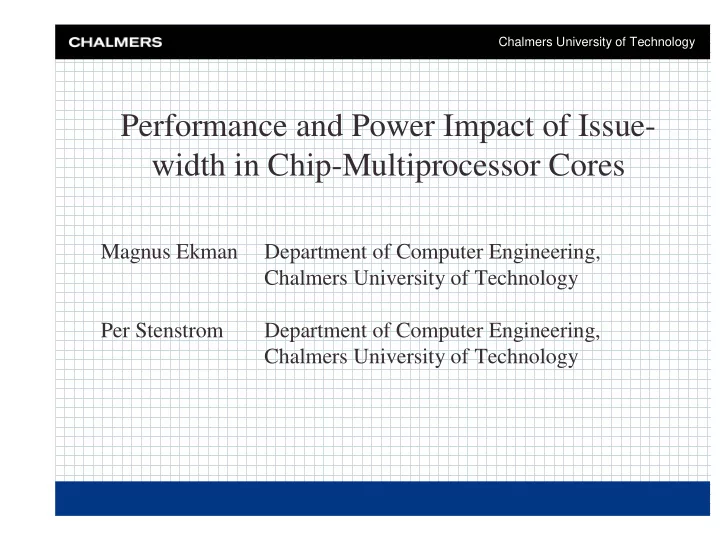

Chalmers University of Technology Performance and Power Impact of Issue- width in Chip-Multiprocessor Cores Magnus Ekman Department of Computer Engineering, Chalmers University of Technology Per Stenstrom Department of Computer Engineering, Chalmers University of Technology
Chalmers University of Technology Outline • Problem statement • Assumptions and studied system • Methodology • Results • Conclusion
Chalmers University of Technology Problem • What is the best trade-off between the number of cores and their complexity in a CMP? • Wide design space ranging from very few very complex superscalar processors to lots of very simple single-issue cores.
Chalmers University of Technology Assumptions • Chip-area requirements are constant in all designs • Clock frequency is constant in all designs • Parallel applications
Chalmers University of Technology Assumptions & Disclamers • Chip-area requirements are constant in all designs Very rough area estimates • Clock frequency is constant in all designs Perhaps more realistic with faster clock for simpler designs • Parallel applications The world is not entirely parallel
Chalmers University of Technology Four basic systems studied • 2 cores, 8-issue • 4 cores, 4-issue • 8 cores, dual-issue • 16 cores, single-issue
Chalmers University of Technology Things that we study •Total execution time of the same task on all systems How does applications exploit ILP vs. TLP? •Power consumption for the different systems Gives hints about hot-spots in the designs •Total energy consumption of executing the same task on all systems How efficient is the system?
Chalmers University of Technology Simulation methodology (complexity effective?) Multiprocessor version of SimWattch [1] SimWattch is based on Simics [2] and Wattch [3] (which is based on SimpleScalar [4] and Cacti [5]). •[1] SimWattch, 2003 IEEE International Symposium on Performance Analysis of Systems and Software •[2] www.simics.net •[3] ISCA 2000 •[4] www.simplescalar.org •[5] research.compaq.com/wrl/people/jouppi/CACTI.html
Chalmers University of Technology How it works • Simics generates traces dynamically • Traces are fed into the detailed processor simulators, which tell Simics if they can handle more instructions or if they should stall. • Activity counters are used in order to get an estimation of energy consumption
Chalmers University of Technology Simulation parameters all systems •SimpleScalar pipeline •Snoop-based MOESI protocol •Shared bus, with contention modeled •Shared L2-Cache: 2M, 8-way •L1-latency: 1 cycle •L2-latency: 12 cycles+bus-arb. •Mem-latency: 128 cycles
Chalmers University of Technology Simulation parameters 8-issue core Issue-width: 8 Window and ROB-size: 128 Load/Store-queue: 64 G-Share BP: 16K-entries Branch Target Buffer: 4K-entries Return Address Stack: 8 entries L1I-Cache 64K, 2-way L1D-Cache 64K, 4-way
Chalmers University of Technology Scaling methodology •Everything except return address stack is scaled linearly. •Tend to favor systems with many cores.
Chalmers University of Technology Benchmarks Parallel applications from Splash-2 • Cholesky • Raytrace • FFT • Radix • Water-sp
Chalmers University of Technology Execution time
Chalmers University of Technology Instructions per cycle
Chalmers University of Technology Executed instructions 1IPC system Baseline system
Chalmers University of Technology IPC with perfect memory
Chalmers University of Technology Execution time with longer memory latency (3x) Increased execution time Cholesky: 114% Radix: 112% FFT: 103% Water: 61% Raytrace: 94%
Chalmers University of Technology Power consumption Radix FFT Water-sp
Chalmers University of Technology Energy consumption Radix FFT Water-sp
Chalmers University of Technology Conclusions • Four 4-issue cores seem to yield almost as good performance as more cores for these multi-threaded applications. • Considering power and energy, four or eight cores seem beneficial. • Choose four cores in order to achieve good single-thread performance!
Recommend
More recommend